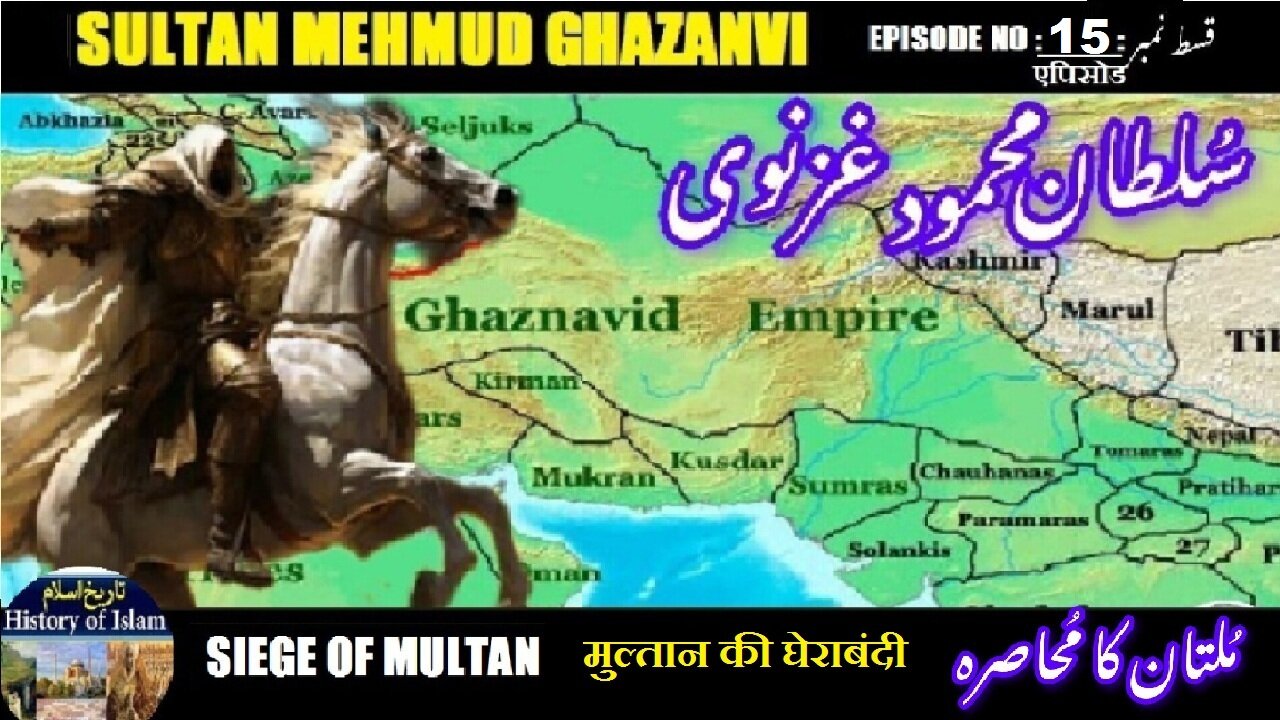Premium Only Content

Sultan Mehmud Ghazanvi Episode-15-एपिसोड Siege of Multan मुल्तान की घेराबंदी ملتان کا محاصرہ
@islamichisory813 #islamichistory #islamicwarriorleader #sultanmahmudghaznvi #series, #warriorking #idolbreaker #biography #achievements #warriorhistory #inspiringlegends #épisode15
Sultan Mehmud Ghazanvi Episode-15-एपिसोड Siege of Multan मुल्तान की घेराबंदी ملتان کا محاصرہ
Asslamoalaikum, We Welcome in our series dedicated to the remarkable life of Islamic warrior leader Sultan Mehmud Ghazanvi. Each episode will provide insight into his life, highlighting the values and principles that have defined his legacy.
Sultan Mahmud Ghaznvi, the idol-breaker, is a shining star in Islamic history of whom the Muslims of the subcontinent can truly be proud. Under extremely difficult circumstances, he laid the first brick of Islam in the region by carrying out seventeen attacks on the Somnath temple, a symbol of Hindu pride in the subcontinent. Bigoted Hindus and others try to portray Sultan Mahmud Ghazni as a robber and looter in their books. Although in his view, the promotion of Islam was more important than wealth.If we take a closer look at his live, the truth becomes clear.
Through a conspiracy, the history of Muslim heroes in the subcontinent is being erased from social sciences, history and geography, which is a very scary trend because it will make our young generation forget the hard work and success of our heroes.
Sultan Mahmud Ghaznvi was born on Nov. 2, 971, Yamin ad-Dawlah Abdul-Qasim Mahmud ibn Sabuktegin, better known as Mahmud of Ghazni, was born in the town of Ghazni, in southeast Afghanistan. His father Abu Mansur Sabuktegin was Turkic, a former Mamluk enslaved warrior from Ghazni.
When the Samanid dynasty, based in Bukhara began to crumble, Sabuktegin seized control of his hometown of Ghazni in 977. He then conquered other major Afghan cities, such as Kandahar. His kingdom formed the core of the Ghaznavid Empire, and he is credited with founding the dynasty.
On his deathbed, Sabuktegin passed over his militarily and diplomatically skilled eldest son Mahmud, 27, in favor of the second son, Ismail. It seems likely that he chose Ismail because he was not descended from enslaved people on both sides, unlike the elder and younger brothers.
When Mahmud, who was stationed at Nishapur, heard of his brother's appointment to the throne, he immediately marched east to challenge Ismail's right to rule. Mahmud overcame his brother's supporters in 998, seized Ghazni, took the throne for himself, and placed his younger brother under house arrest for the rest of his life.
By 1001, Mahmud had turned his attention to the fertile lands of the Punjab, now in India, which lay southeast of his empire. The target region belonged to fierce but fractious Hindu Rajput kings, who refused to coordinate their defense against the Muslim threat from Afghanistan. In addition, the Rajputs used a combination of infantry and elephant-mounted cavalry, a formidable but slower-moving form of army than the Ghaznavids' horse cavalry.
Over the next three decades, Mahmud of Ghazni would make more than a dozen military strikes into Hindu and Ismaili kingdoms to the south. By the time of his death, Mahmud's empire stretched to the shores of the Indian Ocean at southern Gujarat.
In 1026, the 55-year-old sultan set out to invade the state of Kathiawar, on India's west (Arabian Sea) coast. His army drove as far south as Somnath.
Although Mahmud's troops successfully captured Somnath and destroying , there was troubling news from Afghanistan. A number of other Turkic tribes had risen up to challenge Ghaznavid rule, including the Seljuk Turks, who had already captured Merv (Turkmenistan) and Nishapur (Iran). These challengers had already begun to nibble away at the edges of the Ghaznavid Empire by the time Mahmud died.
His empire would survive until 1187, although it began to crumble from west to east even before his death. In 1151, the Ghaznavid sultan Bahram Shah lost Ghazni itself, fleeing to Lahore (Pakistan).
The Sultan Mahmud spent much of his life battling against what he called "infidels"—Hindus, Jains, Buddhists, and Muslim splinter-groups such as the Ismailis. In fact, the Ismailis seem to have been a particular target of his wrath, since Mahmud (and his nominal overlord, the Abbasid caliph) considered them heretics.
Sultan Mehmed II's conquest which led to the fall of the Byzantine Empire was prophesied by the Prophet Muhammad ? in his famous narration (hadith): “Verily you shall conquer Constantinople. What a wonderful leader will he be, and what a wonderful army will that army be!"
On 30 April 1030 Sultan Mahmud died in Ghazni at the age of 58. Sultan Mahmud had contracted malaria during his last invasion.
So, starting tomorrow, we will be presented you with videos based on the biography, conquests, and his life of Sultan Mahmud Ghaznavi on a daily basis at this same time. Hope you will enjoy our all informative videos.
.
Allah Hafiz
-
 6:57
6:57
ISLAMIC HISTORY
1 day agoQutb al-Din al-Shirazi | कुतुब अल-दीन अल-शिराज़ी | سوانح حیات قطب الدین الشیرازی اور مزار کی تاریخ
23 -
 1:18:24
1:18:24
Glenn Greenwald
3 hours agoZelensky Rejects Trump's Ukraine Proposal; What Happened to the Epstein Files? Plus: Richard Medhurst Facing Criminal Charges in UK for Israel Reporting | SYSTEM UPDATE #442
58K29 -
 1:01:11
1:01:11
BonginoReport
4 hours agoGeorge Soros Thwarting President Trump’s Border Agenda?! - Nightly Scroll - Hayley Caronia (Ep.33)
83.4K83 -
 1:10:13
1:10:13
Kim Iversen
4 hours agoAncient Cover-Up: Here's WHY They're Hiding The Truth About The Egyptian Pyramids
63.2K50 -
 17:53
17:53
Exploring With Nug
9 hours ago $2.02 earnedCaught on the Water During a Tornado Warning! Magnet Fishing Gets Scary!
27.4K1 -
 LIVE
LIVE
Melonie Mac
2 hours agoGo Boom Live Ep 46!
209 watching -
 29:25
29:25
CatfishedOnline
8 hours agoWoman’s Celebrity BF Demands $20M Ransom!
5K -
 15:40
15:40
Tundra Tactical
2 hours agoWho Will Be the FIRST 2A CZAR?
3.25K1 -
 12:22
12:22
China Uncensored
6 hours agoXi Jinping's Days Are Numbered
5.93K2 -
 LIVE
LIVE
The Jimmy Dore Show
3 hours agoJordan Peterson Wants “Guardrails” on Rogan’s Guests! RFK Drops Hammer on Food Dyes! w/Ashton Forbes
11,288 watching